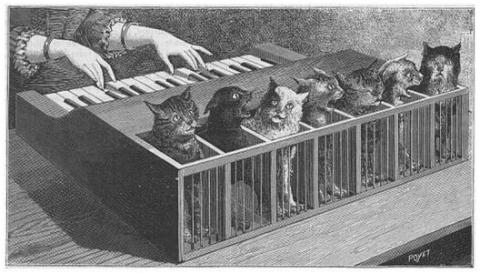
Athanasius Kircher was one of the best known Jesuit scholars of the 17th century. Writing in 1650, Kircher described a grotesque musical instrument called the ‘cat piano’:
“To raise the spirits of an Italian prince burdened by the cares of his position, a musician created for him a cat piano. The musician selected cats whose natural voices were at different pitches and arranged them in cages side by side, so that when a key on the piano was pressed, a mechanism drove a sharp needle into the appropriate cat’s tail. The result was a melody of miaows… who could not help but laugh at such music? Thus was the prince raised from his melancholy.”
While there is no extant historical evidence that a cat piano was ever constructed, it remained a popular piece of whimsy during the 18th and 19th centuries.
A similar device was apparently constructed by the Abbot of Baigne around 1470 but it used pigs rather than cats. According to the chronicler Jean Bouchet, this ‘pig organ’ was built at the request of Louis XI, who asked the Abbott:
“…to get him a concert of swine’s voices, thinking it impossible. The abbot was not surprised but asked for money for the performance, which was immediately delivered… he wrought a thing as singular as ever was seen.”
Bouchet claims the abbot assembled “a great number of hogs of several ages” and above them erected a giant musical keyboard, with one key over each pig. Each key was laced with:
“..little spikes which pricked the hogs [and] made them cry in such order and consonance as highly delighted the king and all his company.”
Source: Athanasius Kircher, Musurgia Universalis, 1650; Jean Bouchet, Annales d’Aquitaine, f.164, c.1550. Content on this page is © Alpha History 2019-23. Content may not be republished without our express permission. For more information please refer to our Terms of Use or contact Alpha History.
